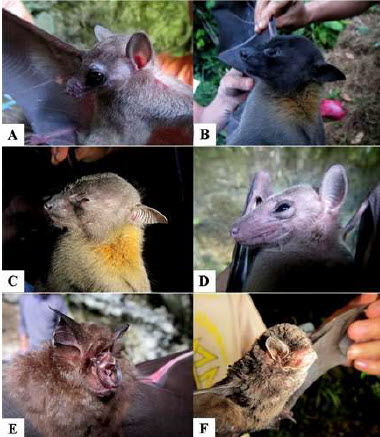Anthropogenic Impacts on Cave-roosting Bats: A Call for Conservation Policy Implementation in Bukidnon, Philippines
Keywords:
Threatened species, Chiroptera, Ecotourism, Conservation, MindanaoAbstract
Many caves in the Philippines are amongst the most popular natural ecotourism sites, even though most of them are poorly regulated and understudied. This study investigates the anthropogenic impacts of unsustainable ecotourism and exploitation on cave-roosting bats in Sumalsag Cave, Bukidnon, Mindanao Island, Philippines. The species richness of the cave-roosting bat fauna was determined using the standard mist-netting method and capture-mark and release technique. The conservation status was assessed based on the International Union for Conservation of Nature (IUCN) Red List. Ecological evaluation and assessment of the cave’s speleological characteristics and ecological condition was carried out using the Philippines’ standard cave assessment protocol. After completing 15 net-nights field sampling with a capture effort of 180 net/hours, results revealed a total of six (6) species of cave-roosting bats which belongs to three (3) families. Two Philippine endemic species, Ptenochirus jagori and Ptenochirus minor were documented including Miniopterus schreibersii, a species classified under near threatened category. Evidence of human activities were considered for identifying the indirect and direct threats on the bat fauna. Destroyed speleothems and speleogens, excavations, modifications of the cave’s features as well as graffiti in the cave walls were recorded. This study recommends regulating eco-tourism activities, protecting the endemic and threatened species and promoting natural restoration of the cave by implementing the existing environmental laws.
References
Agosta, S. J. (2002). Habitat use, diet, and roost selection by the big brown bat (Eptesicus fuscus) in North America: A case for conserving an abundant species. Mammal Review, 32(3), 179-198. doi:10.1046/j.1365-2907.2002.00103.x
Anthony, E. L. P. (1988). Age determination in bats. In. T. H. Kunz (Ed.), Ecological and behavioral methods for the study of bats (pp.
-58). Washington, DC: Smithsonian Institute Press.
Aul, B., Bates, P. J. J., Harrison, D. L., & Marimuthu, G. (2014). Diversity, distribution and status of bats on the Andaman and Nicobar
Islands, India. Oryx, 48(2), 204-212. doi: 10.1017/S0030605312000646
Department of Environment and Natural Resources. (2013). DENR classifies 42 caves in Southern Mindanao . Ret r ieved f rom
http://www.officialgazette.gov.ph/2013/05/29/denr-classifies-42-caves-in-southern-mindanao/
Department of Environment and Natural Resources, Protected Areas and Wildlife Bureau. (2008). A handbook on cave classification for the Philippines. Retrieved from http://www.chm.ph/index.php?option=com_docman&task=doc_download&gid=10&Itemid=76
Elliott, W. R. (2000). Conservation of the North American cave and karst biota. In H. Wilkens, D. C. Culver, & W. F. Humphreys (Eds.), Subterranean ecosystems: Ecosystems of the world (pp. 665-689). Amsterdam: Elsevier.
Fujita, M. S., & Tuttle, M. D. (1991). Flying foxes (Chiroptera: Pteropodidae): Threatened animals of key ecological and economic importance.
Conservation Biology, 5(4), 455-463. doi: 10.1111/j.1523-1739.1991.tb00352.x
Furey, N. M., & Racey, P. A. (2016). Conservation ecology of cave bats. In C. C. Voigt, & T. Kingston (Eds.), Bats in the Anthropocene: Conservation of bats in a changing world (pp. 463-500). Cham, Switzerland: Springer. doi: 10.1007/978-3-319-25220-9_15
Heaney, L. R., Dolar, M. L., Balete, D. S., Esselstyn, J. A., Rickart, E. A., & Sedlock, J. L. (2010). Synopsis of Philippine mammals. Retrieved from http://fieldmuseum.org/explore/ synopsis-philippine-mammals
Hodgkison, R., Balding, S. T., Zubaid, A., & Kunz, T. H. (2003). Fruit bats (Chiroptera, Pteropodidae) as seed dispersers and pollinators in a Lowland Malaysian rain forest. Biotropica, 35(4), 491-502.
Ingle, N. R., & Heaney, L. R. (1992). A key to the bats of the Philippine Islands. Fieldiana: Zoology, 69, 1-44.
International Union for Conservation of Nature. (2014). IUCN SSC Guidelines for minimizing the negative impact to bats and other cave
organisms from guano harvesting, version 1.0. Gland, Switzerland: IUCN Species Survival Commission.
International Union for Conservation of Nature (2017). The IUCN Red List of Threatened Species, version 2017-1. Retrieved from http://www.iucnredlist.org
Jenkins, R. K. B., & Racey, P. A. (2008). Bats as bushmeat in Madagascar. Madagascar Conservation and Development, 3(1), 22-30.
doi:10.4314/mcd.v3i1.44132
Jones, G., Jacobs, D. S., Kunz, T. H., Willig, M. R., & Racey, P. A. (2009). Carpe noctem: The importance of bats as bioindicators. Endangered Species Research, 8, 93-115. doi: 10.3354/esr00182
Kasso, M., & Balakrishnan, M. (2013). Ecological and economic importance of bats (Order Chiroptera). ISRN Biodiversity, 2013, 1-9. doi:
1155/2013/187415
Kingston, T. (2010). Research priorities for bat conservation in Southeast Asia: A consensus approach. Biodiversity and Conservation, 19(2),
-484. doi:10.1007/s10531-008-9458-5
Kunz, T. H., De Torrez, E. B., Bauer, D., Lobova, T., & Fleming, T. H. (2011). Ecosystem services provided by bats. Annals of the New York Academy of Sciences, 1223, 1-38. doi: 10.1111/j.1749-6632.2011.06004.x
Martin, K. W., Leslie, D. M., Payton, M. E., Puckette, W. L., & Hensley, S. L. (2003). Internal cave gating for protection of colonies of the endangered gray bat (Myotis grisescens). Acta Chiropterologica, 5(1), 143-150. doi:10.3161/001.005.0112
McCracken, G. F. (1988). Who's endangered and what can we do? Bats, 6(3), 5-9.
McCracken, G. F. (1989). Cave conservation: Special problems of bats. The National Speleological Society Bulletin, 51(1), 47-51.
Medellin, R. A., Equihua M., & Amin, M. A. (2000). Bat diversity and abundance as indicators of disturbance in Neotropical rainforests. Conservation Biology, 14(6), 1666-1675. doi: 10.1111/j.1523-1739.2000.99068.x
Paguntalan, L. M. J., Pedregosa, M., & Gadiana, M. J. C. (2004). The Philippine bare-backed fruit bat Dobsonia chapmani Rabor, 1952: Rediscovery and conservation status on Cebu Island. Silliman Journal, 45(2), 113-122.
Pennisi, L. A., Holland, S. M., & Stein, T. V. (2004) Achieving bat conservation through tourism. Journal of Ecotourism, 3(3), 195-207. doi:10.1080/14664200508668432
Sedlock, J. L., Ingle, N. R., & Balete, D. S. (2011). Enhanced sampling of bat assemblages: A field test on Mount Banahaw, Luzon. Fieldiana: Life and Earth Sciences, 2, 96-102.
Tanalgo, K. C., & Tabora, J. A. G. (2015). Cavedwelling bats (Mammalia: Chiroptera) and conservation concerns in South Central Mindanao, Philippines. Journal of Threatened Taxa, 7(15), 8185-8194. doi:10.11609/jtt.1757.7.15.8185-8194
Tanalgo, K. C., Teves, R. D., Salvaña, F. R. P., Baleva, R. E., & Tabora, J. A. G. (2016). Human-bat interactions in caves of South Central Mindanao, Philippines. Wildlife Biology in Practice, 12(1), 1-14. doi:10.2461/wbp.2016.12.2













